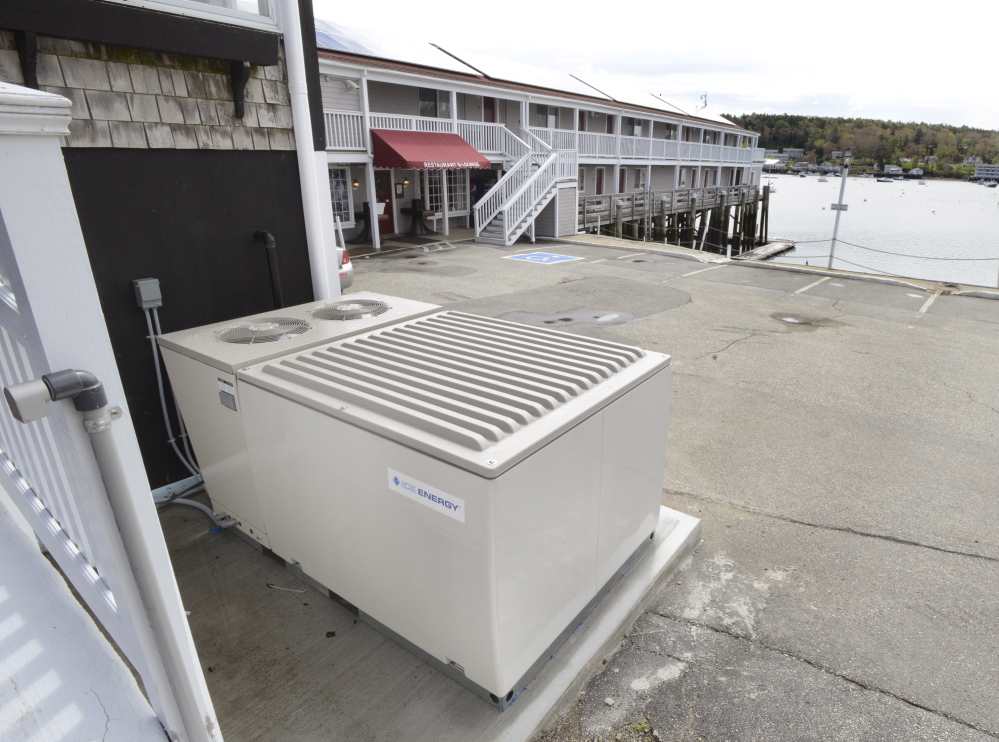BOOTHBAY HARBOR — Can a metal box filled with 450 pounds of ice help keep electric rates from rising even higher?
It sounded like a scam to Ralph Najim when a guy from California came to town last fall and asked if he could install one next to his laundromat and car wash. So Najim called the police and checked in with the Boothbay Harbor Region Chamber of Commerce. Turned out, the chamber was in on the deal. It was having a box installed.
Then the guy from away, Dave Prezioso, chief executive officer of Ice Energy in Glendale, California, told Najim that he also could get a new air conditioner, paid for by Central Maine Power customers.
“I didn’t believe him at first,” Najim said last week, standing next to the $12,000 Ice Bear distributed energy storage unit in front of Coastal Car Wash.
As warm weather approaches, the Boothbay Harbor region is part of a very cool experiment with high-tech storage batteries made of ice.
The Boothbay peninsula is served by a single, high-voltage power line. On the hottest days of the year, that line is in danger of being overloaded. Upgrading it would cost CMP customers $18 million. Instead, a state-approved demonstration project is finding cheaper ways to maintain reliable electric service to this summer resort area, without costly new construction.
In energy speak, the solutions are called non-transmission alternatives and 70 separate measures have so far been carried out. They include switching thousands of high-wattage, heat-producing incandescent light bulbs at local businesses to cool, high-efficiency LEDs. Dozens of solar-electric panels also have gone up, a perfect match, because of their high output on sunny afternoons, just as the strain on the power line peaks.
Taken together, the net cost of installing and operating non-transmission alternatives is roughly one-third that of building a new power line, according to an interim report by GridSolar LLC, the Portland-based company coordinating the experiment for the Maine Public Utilities Commission. That’s why the PUC says it makes financial sense for ratepayers to fund the Ice Bear units and upgrade old air conditioners in businesses participating in the program.
Here in Boothbay Harbor, work crews have put 32 Ice Bear units around town. There are seven at the Spruce Point Inn. Another seven are lined up behind Meadow Mall. A few are next to the Department of Marine Resources and single units are found in places including Town Hall and the Tugboat Inn, which also boasts a large solar-electric array.
The Ice Bear unit is like a battery made of ice. The concept is similar to a battery in a hybrid car. But rather than using chemicals and storing electrical energy, this battery stores cooling energy in the form of ice. A large insulated storage tank filled with water is linked by pipes to a building’s AC system.
It’s a two-step process. At night, Ice Bear shifts into charging mode. When power demand is low and the outside temperature is cooler, the unit freezes 450 gallons of water by pumping refrigerant through copper coils.
The next day, as afternoon temperatures rise and demand increases on the electric grid, Ice Bear switches to cooling mode. The building is cooled with ice made the previous night, rather than the air conditioner’s energy-intensive compressor. The ice cools hot refrigerant and pumps it through a modified evaporator coil in the air conditioner.
The cooling cycle can last six hours, or until the ice has all melted. If more cooling is needed, the regular air conditioner comes back on, but by then, the hottest hours of the day have passed.
The Ice Bear units are connected to a wireless network, so they can be remotely monitored and controlled. This smart-grid capability offers the potential of tweaking the operating schedule of one unit or an entire fleet, based on peak electric demand.
This technology is new to Maine, but it’s becoming common out West. Ice Energy has installed more than 1,200 Ice Bear units for utility projects in California. One project in the Los Angeles area has shifted enough power off peak to serve 10,000 average homes.
The 32 Ice Bear units being installed in the Boothbay region are designed to offset 250 kilowatts of capacity. That’s the rough equivalent of unplugging 75 window air conditioners, Ice Energy says.
Shedding this air conditioning load on hot afternoons is a big deal.
When people think of when the greatest amount of energy is consumed in Maine, they think of winter. But in terms of electricity use, the answer is summer. Since 2004, summer has become the peak season for power demand in CMP’s service territory.
This transition is creating an expensive problem in Maine and the rest of New England. Utility customers are paying billions of dollars in rates to expand and upgrade the region’s transmission system, even though overall demand is hardly growing. But summer is a different story, according to ISO-New England, the region’s grid operator, largely due to the increased use of air conditioning.
Statistics compiled by CMP tell the story. In 2001, an estimated 37 percent of customers had room air conditioners. In 2010, the share had climbed to 79 percent. In its latest forecast, CMP does a calculation that assumes three window air conditioners equal the energy use of one whole-house unit. Based on that figure, CMP is planning for a summer electric load as if 40 percent of its customers will have whole-house air conditioning in 2015.
Factor in a warming climate, increased urban development and the new popularity of air-source heat pumps that double as air conditioners, and the trend seems unstoppable.
“People associate air conditioning issues with the Southwest and very hot climates,” said Mike Hopkins, executive vice president for corporate development at Ice Energy. “Actually, it creates bigger problems for the electricity grid in places like Maine, because you need to build for peak loads.”
In hot climates, Hopkins said, power grids are sized for demand that’s more stable over the course of a year. In New England, the system must be overbuilt to handle extreme summer weather that’s measured in days, but the costs are paid year-round.
The overall Boothbay Harbor project is still being evaluated and tested, to make sure the measures put in place can handle any situation CMP could face in providing reliable power to the community. If the demonstration proves successful, the concept could be expanded to other parts of Maine where power lines are being maxed out during peak periods. Next up could be the Camden-Rockland region and Greater Portland. Based on CMP’s assessment of future growth, GridSolar may propose a suite of non-transmission alternatives for the midcoast, a project at least four times as large as Boothbay.
Larger projects could be done at a lower per-unit cost because of economies of scale, according to Kimball Kenway, vice president of Thermal Energy Storage of Maine. Kenway is acting as Ice Energy’s representative in Maine and has been lining up the host businesses in Boothbay Harbor.
Kenway said Ice Energy is excited about the work here because it gives the company an integrated project to show off in New England. But displacing 250 kilowatts with 32 Ice Bear units is really small change, compared to the 1,200 units chilling in California.
In Maine, single sites in Greater Portland with high air conditioning loads have the greatest potential. An example, Kenway said, would be the Maine Mall.
“We could do 250 kilowatts just at Macy’s,” he said.
Tux Turkel can be contacted at 791-6462 or at:
tturkel@pressherald.com
Send questions/comments to the editors.





Success. Please wait for the page to reload. If the page does not reload within 5 seconds, please refresh the page.
Enter your email and password to access comments.
Hi, to comment on stories you must . This profile is in addition to your subscription and website login.
Already have a commenting profile? .
Invalid username/password.
Please check your email to confirm and complete your registration.
Only subscribers are eligible to post comments. Please subscribe or login first for digital access. Here’s why.
Use the form below to reset your password. When you've submitted your account email, we will send an email with a reset code.